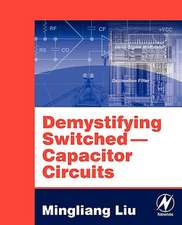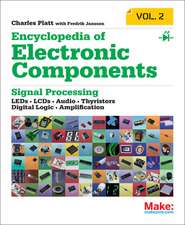Nanometer Technology Designs: High-Quality Delay Tests
Autor Nisar Ahmeden Limba Engleză Paperback – 14 dec 2011
Traditional at-speed test methods cannot guarantee high quality test results as they face many new challenges. Supply noise (including IR-drop, ground bounce, and Ldi/dt) effects on chip performance, high test pattern volume, low fault/defect coverage, small delay defect test pattern generation, high cost of test implementation and application, and utilizing low-cost testers are among these challenges. This book discusses these challenges in detail and proposes new techniques and methodologies to improve the overall quality of the transition fault test.
| Toate formatele și edițiile | Preț | Express |
|---|---|---|
| Paperback (1) | 640.55 lei 6-8 săpt. | |
| Springer Us – 14 dec 2011 | 640.55 lei 6-8 săpt. | |
| Hardback (1) | 647.73 lei 6-8 săpt. | |
| Springer Us – 20 dec 2007 | 647.73 lei 6-8 săpt. |
Preț: 640.55 lei
Preț vechi: 753.60 lei
-15% Nou
Puncte Express: 961
Preț estimativ în valută:
122.57€ • 128.31$ • 101.42£
122.57€ • 128.31$ • 101.42£
Carte tipărită la comandă
Livrare economică 07-21 aprilie
Preluare comenzi: 021 569.72.76
Specificații
ISBN-13: 9781441945594
ISBN-10: 1441945598
Pagini: 300
Ilustrații: XVIII, 281 p. 140 illus.
Dimensiuni: 155 x 235 x 16 mm
Greutate: 0.42 kg
Ediția:2008
Editura: Springer Us
Colecția Springer
Locul publicării:New York, NY, United States
ISBN-10: 1441945598
Pagini: 300
Ilustrații: XVIII, 281 p. 140 illus.
Dimensiuni: 155 x 235 x 16 mm
Greutate: 0.42 kg
Ediția:2008
Editura: Springer Us
Colecția Springer
Locul publicării:New York, NY, United States
Public țintă
ResearchCuprins
Introduction to path delay and transition delay fault models and test methods.- At-speed test challenges for nanometer technology designs.- Low-cost tester friendly design-for-test techniques.- Improving test quality of current at-speed test methods.- Functionally untestable fault list generation and avoidance.- Timing-based ATPG for screening small delay faults.- Faster-than-at-speed test considering IR-drop effects.- IR-drop tolerant at-speed test pattern generation and application.
Textul de pe ultima copertă
While adopting newer, better fabrication technologies provides higher integration and enhances performance, it also increases the types of manufacturing defects. With design size in millions of gates and working frequency in GHz, timing-related defects have become a high proportion of the total chip defects. For nanometer technology designs, the traditional test methods cannot ensure a high quality level of chips, and at-speed tests using path and transition delay fault model have become a requirement in technologies below 180nm.
Nanometer Technology Designs: High-Quality Delay Tests discusses these challenges in detail and proposes new techniques and methodologies to improve the overall quality of the delay test for nanotechnology designs. Topics covered include:
Nanometer Technology Designs: High-Quality Delay Tests discusses these challenges in detail and proposes new techniques and methodologies to improve the overall quality of the delay test for nanotechnology designs. Topics covered include:
- At-speed test challenges for nanotechnology
- Low-cost tester-friendly design-for-test techniques
- Improving test quality of current at-speed test methods
- Functionally un-testable fault list generation and avoidance
- Timing-based ATPG for screening small delay faults
- Faster-than-at-speed test considering power supply noise
- Power supply noise tolerant at-speed test pattern generation and application
- Solutions for dealing with crosstalk and signal integrity issues
Caracteristici
Identifies defects in traditional at-speed test methods Proposes new techniques and methodologes to improve the overall quality of transition fault tests Includes discussion of the effects of IR-drop Provides an introduction to path delay and transition delay fault models and test methods Includes supplementary material: sn.pub/extras













